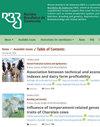Does the use of corn and soybean hulls affect calf performance in the preweaning period?
IF 1.2
4区 农林科学
Q3 Agricultural and Biological Sciences
Revista Brasileira De Zootecnia-Brazilian Journal of Animal Science
Pub Date : 2023-07-10
DOI:10.37496/rbz5220200241
引用次数: 0
Abstract
- The objective of this study was to assess the effects of two levels of soybean hulls (0 and 400.1 g/kg) and whole or ground corn in the diet of newborn crossbred dairy male calves on intake, performance, blood indicators, and feeding cost. Twenty-eight calves with an average weight of 33.0±6.2 kg and four days of age were distributed into four treatment groups in a completely randomized design (n = 7) for 56 days. Weekly samples of feed, diets, and leftovers were collected to determine dry matter and nutrient intakes. To evaluate apparent digestibility, samples were taken using titanium dioxide as a maker. Blood samples were also collected to evaluate blood indicators. The inclusion of soybean hulls resulted in greater neutral detergent fiber intake by the calves, but reduced their non-fibrous carbohydrates intake, which was also reduced by the use of whole corn in the diet. Although the total digestible nutrients content of diets decreased with the use of whole corn and inclusion of soybean hulls, its intake did not vary (0.75 kg/d), regardless of the factors analyzed. The apparent digestibilities of dry matter (0.87 kg/kg) and crude protein (0.89 kg/kg) were similar, resulting in similar performance between the animals, regardless of the factors analyzed. In the quantities evaluated, the use of soybean hulls or whole corn did not affect blood indicators and was insufficient to reduce feed costs; the cost of daily feed was $2.06, while the cost per kilogram of gain was $3.74. The inclusion of up to 400.1 g/kg of soybean hulls or the replacement of ground corn with whole corn does not affect the performance of crossbred dairy calves during the preweaning period, demonstrating that both can be used in animal feed during this phase of production玉米和大豆皮的使用对断奶前犊牛生产性能有影响吗?
-本研究旨在评估新生杂交乳雄性犊牛日粮中大豆皮(0和40.1 g/kg)和全玉米或碎玉米两种水平对采食量、生产性能、血液指标和饲养成本的影响。选取28头平均体重为33.0±6.2 kg、4日龄的犊牛,采用完全随机设计分为4个处理组(n = 7),试验期56 d。每周收集饲料、日粮和剩菜样品,以确定干物质和营养摄入量。为了评估表观消化率,样品采用二氧化钛作为制造商。同时采集血液样本,评估血液指标。大豆皮的加入增加了犊牛中性洗涤纤维的摄入量,但减少了它们非纤维性碳水化合物的摄入量,这也因在饲料中使用全玉米而减少。尽管饲粮中总可消化营养素含量随着全玉米和大豆皮的添加而降低,但其摄入量没有变化(0.75 kg/d),无论分析的因素如何。各组动物的干物质表观消化率(0.87 kg/kg)和粗蛋白质表观消化率(0.89 kg/kg)基本一致,生产性能基本一致。在评价的数量中,大豆皮或全玉米的使用对血液指标没有影响,不足以降低饲料成本;日饲料成本为2.06美元,每公斤增重成本为3.74美元。添加高达40.1 g/kg的大豆皮或用全玉米代替磨碎的玉米不会影响杂交奶牛犊牛在断奶前的生产性能,这表明两者都可以在这一生产阶段用作动物饲料
本文章由计算机程序翻译,如有差异,请以英文原文为准。
求助全文
约1分钟内获得全文
求助全文
来源期刊
CiteScore
1.90
自引率
0.00%
发文量
25
审稿时长
8 weeks
期刊介绍:
The Revista Brasileira de Zootecnia (RBZ; Brazilian Journal of Animal Science) encompasses all fields of Animal Science Research. The RBZ publishes original scientific articles in the areas of Aquaculture, Biometeorology and Animal Welfare, Forage Crops and Grasslands, Animal and Forage Plants Breeding and Genetics, Animal Reproduction, Ruminant and Non-Ruminant Nutrition, and Animal Production Systems and Agribusiness.

 求助内容:
求助内容: 应助结果提醒方式:
应助结果提醒方式:


